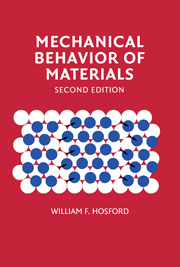Book contents
- Frontmatter
- Contents
- Preface
- 1 Stress and Strain
- 2 Elasticity
- 3 Mechanical Testing
- 4 Strain Hardening of Metals
- 5 Plasticity Theory
- 6 Strain Rate and Temperature Dependence of Flow Stress
- 7 Slip and Crystallographic Textures
- 8 Dislocation Geometry and Energy
- 9 Dislocation Mechanics
- 10 Mechanical Twinning and Martenitic Shear
- 11 Hardening Mechanisms in Metals
- 12 Discontinuous and Inhomogeneous Deformation
- 13 Ductility and Fracture
- 14 Fracture Mechanics
- 15 Viscoelasticity
- 16 Creep and Stress Rupture
- 17 Fatigue
- 18 Residual Stresses
- 19 Ceramics and Glasses
- 20 Polymers
- 21 Composites
- 22 Mechanical Working
- APPENDIX I Miller Indices
- APPENDIX II Stereographic Representation of Orientations
- Index
14 - Fracture Mechanics
Published online by Cambridge University Press: 05 June 2012
- Frontmatter
- Contents
- Preface
- 1 Stress and Strain
- 2 Elasticity
- 3 Mechanical Testing
- 4 Strain Hardening of Metals
- 5 Plasticity Theory
- 6 Strain Rate and Temperature Dependence of Flow Stress
- 7 Slip and Crystallographic Textures
- 8 Dislocation Geometry and Energy
- 9 Dislocation Mechanics
- 10 Mechanical Twinning and Martenitic Shear
- 11 Hardening Mechanisms in Metals
- 12 Discontinuous and Inhomogeneous Deformation
- 13 Ductility and Fracture
- 14 Fracture Mechanics
- 15 Viscoelasticity
- 16 Creep and Stress Rupture
- 17 Fatigue
- 18 Residual Stresses
- 19 Ceramics and Glasses
- 20 Polymers
- 21 Composites
- 22 Mechanical Working
- APPENDIX I Miller Indices
- APPENDIX II Stereographic Representation of Orientations
- Index
Summary
Introduction
The treatment of fracture in Chapter 13 was descriptive and qualitative. In contrast, fracture mechanics provides a quantitative treatment of fracture. It allows measurements of the toughness of materials and provides a basis for predicting the loads that structures can withstand without failure. Fracture mechanics is useful in evaluating materials, in the design of structures, and in failure analysis.
Early calculations of strength for crystals predicted strengths far in excess of those measured experimentally. The development of modern fracture mechanics started when it was realized that strength calculations based on assuming perfect crystals were far too high because they ignored preexisting flaws. Griffith reasoned that a preexisting crack could propagate under stress only if the release of elastic energy exceeded the work required to form the new fracture surfaces. However, his theory based on energy release predicted fracture strengths that were much lower than those measured experimentally. Orowan realized that plastic work should be included in the term for the energy required to form a new fracture surface. With this correction, experiment and theory were finally brought into agreement. Irwin offered a new and entirely equivalent approach by concentrating on the stress states around the tip of a crack.
Theoretical Fracture Strength
Early estimates of the theoretical fracture strength of a crystal were be made by considering the stress required to separate two planes of atoms. Figure 14.1 shows schematically how the stress might vary with separation.
- Type
- Chapter
- Information
- Mechanical Behavior of Materials , pp. 225 - 243Publisher: Cambridge University PressPrint publication year: 2009

